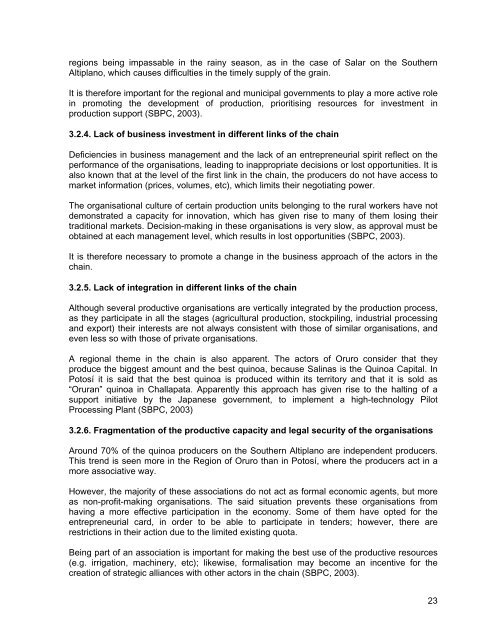Study on the social, environmental and economic impacts of quinoa ...
Study on the social, environmental and economic impacts of quinoa ...
Study on the social, environmental and economic impacts of quinoa ...
You also want an ePaper? Increase the reach of your titles
YUMPU automatically turns print PDFs into web optimized ePapers that Google loves.
egi<strong>on</strong>s being impassable in <strong>the</strong> rainy seas<strong>on</strong>, as in <strong>the</strong> case <strong>of</strong> Salar <strong>on</strong> <strong>the</strong> Sou<strong>the</strong>rn<br />
Altiplano, which causes difficulties in <strong>the</strong> timely supply <strong>of</strong> <strong>the</strong> grain.<br />
It is <strong>the</strong>refore important for <strong>the</strong> regi<strong>on</strong>al <strong>and</strong> municipal governments to play a more active role<br />
in promoting <strong>the</strong> development <strong>of</strong> producti<strong>on</strong>, prioritising resources for investment in<br />
producti<strong>on</strong> support (SBPC, 2003).<br />
3.2.4. Lack <strong>of</strong> business investment in different links <strong>of</strong> <strong>the</strong> chain<br />
Deficiencies in business management <strong>and</strong> <strong>the</strong> lack <strong>of</strong> an entrepreneurial spirit reflect <strong>on</strong> <strong>the</strong><br />
performance <strong>of</strong> <strong>the</strong> organisati<strong>on</strong>s, leading to inappropriate decisi<strong>on</strong>s or lost opportunities. It is<br />
also known that at <strong>the</strong> level <strong>of</strong> <strong>the</strong> first link in <strong>the</strong> chain, <strong>the</strong> producers do not have access to<br />
market informati<strong>on</strong> (prices, volumes, etc), which limits <strong>the</strong>ir negotiating power.<br />
The organisati<strong>on</strong>al culture <strong>of</strong> certain producti<strong>on</strong> units bel<strong>on</strong>ging to <strong>the</strong> rural workers have not<br />
dem<strong>on</strong>strated a capacity for innovati<strong>on</strong>, which has given rise to many <strong>of</strong> <strong>the</strong>m losing <strong>the</strong>ir<br />
traditi<strong>on</strong>al markets. Decisi<strong>on</strong>-making in <strong>the</strong>se organisati<strong>on</strong>s is very slow, as approval must be<br />
obtained at each management level, which results in lost opportunities (SBPC, 2003).<br />
It is <strong>the</strong>refore necessary to promote a change in <strong>the</strong> business approach <strong>of</strong> <strong>the</strong> actors in <strong>the</strong><br />
chain.<br />
3.2.5. Lack <strong>of</strong> integrati<strong>on</strong> in different links <strong>of</strong> <strong>the</strong> chain<br />
Although several productive organisati<strong>on</strong>s are vertically integrated by <strong>the</strong> producti<strong>on</strong> process,<br />
as <strong>the</strong>y participate in all <strong>the</strong> stages (agricultural producti<strong>on</strong>, stockpiling, industrial processing<br />
<strong>and</strong> export) <strong>the</strong>ir interests are not always c<strong>on</strong>sistent with those <strong>of</strong> similar organisati<strong>on</strong>s, <strong>and</strong><br />
even less so with those <strong>of</strong> private organisati<strong>on</strong>s.<br />
A regi<strong>on</strong>al <strong>the</strong>me in <strong>the</strong> chain is also apparent. The actors <strong>of</strong> Oruro c<strong>on</strong>sider that <strong>the</strong>y<br />
produce <strong>the</strong> biggest amount <strong>and</strong> <strong>the</strong> best <strong>quinoa</strong>, because Salinas is <strong>the</strong> Quinoa Capital. In<br />
Potosí it is said that <strong>the</strong> best <strong>quinoa</strong> is produced within its territory <strong>and</strong> that it is sold as<br />
“Oruran” <strong>quinoa</strong> in Challapata. Apparently this approach has given rise to <strong>the</strong> halting <strong>of</strong> a<br />
support initiative by <strong>the</strong> Japanese government, to implement a high-technology Pilot<br />
Processing Plant (SBPC, 2003)<br />
3.2.6. Fragmentati<strong>on</strong> <strong>of</strong> <strong>the</strong> productive capacity <strong>and</strong> legal security <strong>of</strong> <strong>the</strong> organisati<strong>on</strong>s<br />
Around 70% <strong>of</strong> <strong>the</strong> <strong>quinoa</strong> producers <strong>on</strong> <strong>the</strong> Sou<strong>the</strong>rn Altiplano are independent producers.<br />
This trend is seen more in <strong>the</strong> Regi<strong>on</strong> <strong>of</strong> Oruro than in Potosí, where <strong>the</strong> producers act in a<br />
more associative way.<br />
However, <strong>the</strong> majority <strong>of</strong> <strong>the</strong>se associati<strong>on</strong>s do not act as formal ec<strong>on</strong>omic agents, but more<br />
as n<strong>on</strong>-pr<strong>of</strong>it-making organisati<strong>on</strong>s. The said situati<strong>on</strong> prevents <strong>the</strong>se organisati<strong>on</strong>s from<br />
having a more effective participati<strong>on</strong> in <strong>the</strong> ec<strong>on</strong>omy. Some <strong>of</strong> <strong>the</strong>m have opted for <strong>the</strong><br />
entrepreneurial card, in order to be able to participate in tenders; however, <strong>the</strong>re are<br />
restricti<strong>on</strong>s in <strong>the</strong>ir acti<strong>on</strong> due to <strong>the</strong> limited existing quota.<br />
Being part <strong>of</strong> an associati<strong>on</strong> is important for making <strong>the</strong> best use <strong>of</strong> <strong>the</strong> productive resources<br />
(e.g. irrigati<strong>on</strong>, machinery, etc); likewise, formalisati<strong>on</strong> may become an incentive for <strong>the</strong><br />
creati<strong>on</strong> <strong>of</strong> strategic alliances with o<strong>the</strong>r actors in <strong>the</strong> chain (SBPC, 2003).<br />
23

















